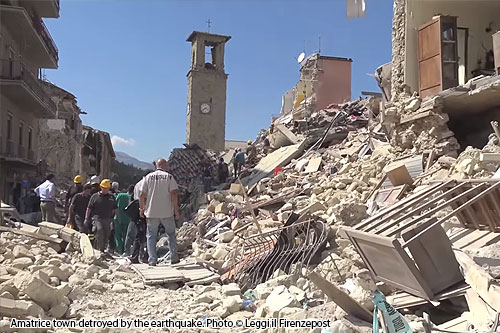As rescue teams wind up their efforts to find survivors of a devastating 6.2 earthquake that shook central Italy last month with loss of 296 lives, another concern emerges – the fate of hundreds of historic buildings destroyed or damaged in the quake. Italy’s Minister of Culture, Dario Franceschini, reported at least 293 cultural heritage sites damaged in the seismic area.
The Carabinieri Corps for the Protection of Cultural Heritage has listed more than 50 historic sites seriously damaged or destroyed during the earthquake – mainly small village churches, icons of rural identity and centres of life in the villages and towns struck by the earthquake.
ICCROM’s Director-General, Stefano De Caro expressed shock and sadness at the loss of life, and offered his agency’s support in providing technical assistance in the restoration of priceless cultural assets. De Caro, who had been involved in the aftermath of the deadly 1980 Irpinia earthquake in southern Italy that claimed over 2000 lives, said he was deeply affected by the most recent disaster. “ICCROM is in contact with Italian authorities, both to offer technical assistance and support, and also to share the experience of Italian technical and heritage professionals to benefit the international community,” he said.
Historic buildings in the three towns of Amatrice, Accumoli and Arquata del Tronto were destroyed in the quake. In Amatrice, the Basilica di San Francesco and the church of Sant’Agostino partially collapsed. The town’s clock tower was also severely damaged. The clock face stopped at 3.36am, the moment the earthquake struck.
“ICCROM gathers experiences of earthquakes and other natural disasters affecting cultural heritage worldwide,” observed De Caro. “We are deeply aware of the consequences that the loss of heritage has on communities. For this reason, ICCROM has participated in the international awareness campaign to support the increasing resilience of cities in the wake of catastrophes, on the basis of the Sendai Framework for Disaster Risk Reduction.”
Cultural restoration experts say the area was very well known as an example of medieval settlements in the central Italian mountain region of the Apennines. For art historians, as reported by several international media sources such as the Washington Post, Amatrice and nearby towns “have always been frozen in time, and their unspoiled longevity — as opposed to any specific building or work of art — was their true legacy.”
Italian and international media reports point to the strong links between the local communities and their cultural heritage, noting assets such as the rural, simple beauty of the towns of this cultural landscape, the vernacular construction methods, and the living heritage inside communities. “Traditions cannot die,” said an Amatrice resident in an interview.
 ICCROM has offered assistance to the Italian authorities in term of crisis mapping to document and map the damage, post-disaster needs assessment and on-site volunteer training. These actions are intended to help prevent further damage or loss of cultural properties. ICCROM has also launched the Centro Crisis Culturale Crowdmap in collaboration with CHIEF – Cultural Heritage International Emergency Force, and with CESMAR7 – Centro per lo Studio dei Materiali per il Restauro, in order to gather on-site reports of cultural heritage damage in preparation for salvage activities. ICCROM has also been invited by Italian National Commission of the Blue Shield to participate in a technical round table together with ICOMOS Italia.
ICCROM has offered assistance to the Italian authorities in term of crisis mapping to document and map the damage, post-disaster needs assessment and on-site volunteer training. These actions are intended to help prevent further damage or loss of cultural properties. ICCROM has also launched the Centro Crisis Culturale Crowdmap in collaboration with CHIEF – Cultural Heritage International Emergency Force, and with CESMAR7 – Centro per lo Studio dei Materiali per il Restauro, in order to gather on-site reports of cultural heritage damage in preparation for salvage activities. ICCROM has also been invited by Italian National Commission of the Blue Shield to participate in a technical round table together with ICOMOS Italia.
According to initial assessments, the nearest World Heritage property to the epicentre of the quake, the Basilica of Saint Francis of Assisi, has been spared in the recent disaster.
SEE ALSO
Lost heritage: Massive quake deals blow to Italy's art treasures - FOX News
Italian towns take stock of losses to the region’s cultural heritage - The Washington Post

